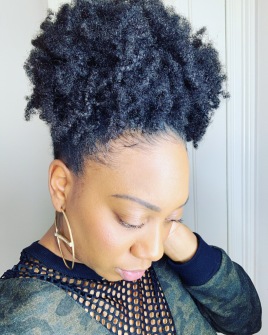After my big chop, my hair was extremely dry. I quickly found out that I was moisturizing my hair all wrong! To resolve my dry hair, I researched how to moisturize my natural hair. I have type 4, low porosity hair. Type 4 hair is considered kinky coily. Low porosity means that my hair has a hard time absorbing moisture. Before I found the proper way to moisturize my hair, the product would just sit on my hair and it would take forever and a day for my hair to air dry. Of course you know I had to do my research and I found out about the LOC method. It stands for Liquid-Oil-Cream.
The L.O.C. method is one of the best ways to moisturize natural hair and it can be done in 3 easy steps. The first step consists of hydrating you hair with water or a water- based product (liquid), then sealing in the moisture (oil) and then applying a cream product to close cuticle, which prevents the hair from losing moisture.
This method is one of the best guides on how to apply products to the hair and ensures that hair is moisturized for a longer period of time.

Here’s Why the LOC Method Works!!!
Water = Moisture! We all know that water or water-based products contain a lot of hydrating properties. The issue is retaining the moisture from the water, or water-based products. That’s where the oil and cream comes into play.
The oil helps the hair hold on to water molecules. It is important that you use an oil that has the ability to penetrate. Examples of penetrating oils are: avocado, babassu, coconut, and olive oil. These oils increase your hair’s ability to hold on to water molecules.
The cream locks in the moisture. It is important to use a moisturizing cream.

How to Do the LOC Method
L-Liquid
The simplest way to do the L in the LOC method, is simply by washing your hair. In the past I have used a water-based leave-in such as Jane Carter Solution Revitalizing Leave In Conditioner.
This method can also be done in-between wash days and you can use a spray bottle with water, or a water-based leave in for your L.
O-Oil
The type of oil you use is very important. There are a variety of oils. There is a difference between moisturizing oils, sealing oils, and penetrating oils. As mentioned before it is best to use penetrating oils for this step.
Oils will not add moisture to your hair, but the penetrating oils will aid in retaining moisture from the water.
C-Cream
As you know there are different types of creams on the market. For this step it doesn’t matter which cream you use, but as long as you are using a moisturizing cream. Some leave-in conditioners are creams, and that would be totally fine to use.
What about the LCO Method?
The LCO Method is also another way to moisturize natural hair. The product layering is a little different. For this method you would apply the products: Liquid-Cream-Oil. When I was researching the best way to moisturize my natural hair, this method came up as well. It really depends on your hair porosity and hair type. Like with anything, it is trial and error. I would try each method on your hair to determine which method works for you.
Personally I have tried both layering methods, but I prefer the LOC method. I noticed that my hair retains moisture for a longer period of time and my styles usually come out much better when I layer my products using the LOC Method.
Have you tried the LOC or LCO method? Which one do you prefer?
Well until next time, Love & Light!
Meaghan Lindsey


0 Comments